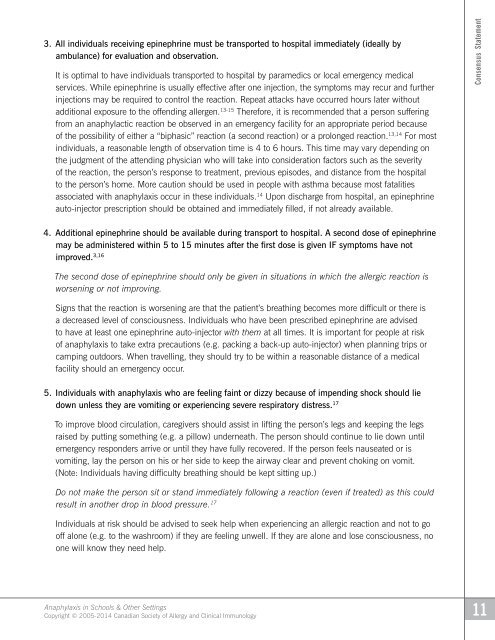Anaphylaxis in Schools 3rd Edition
Anaphylaxis in Schools 3rd Edition
Anaphylaxis in Schools 3rd Edition
Create successful ePaper yourself
Turn your PDF publications into a flip-book with our unique Google optimized e-Paper software.
3. All <strong>in</strong>dividuals receiv<strong>in</strong>g ep<strong>in</strong>ephr<strong>in</strong>e must be transported to hospital immediately (ideally by<br />
ambulance) for evaluation and observation.<br />
It is optimal to have <strong>in</strong>dividuals transported to hospital by paramedics or local emergency medical<br />
services. While ep<strong>in</strong>ephr<strong>in</strong>e is usually effective after one <strong>in</strong>jection, the symptoms may recur and further<br />
<strong>in</strong>jections may be required to control the reaction. Repeat attacks have occurred hours later without<br />
additional exposure to the offend<strong>in</strong>g allergen. 13-15 Therefore, it is recommended that a person suffer<strong>in</strong>g<br />
from an anaphylactic reaction be observed <strong>in</strong> an emergency facility for an appropriate period because<br />
of the possibility of either a “biphasic” reaction (a second reaction) or a prolonged reaction. 13,14 For most<br />
<strong>in</strong>dividuals, a reasonable length of observation time is 4 to 6 hours. This time may vary depend<strong>in</strong>g on<br />
the judgment of the attend<strong>in</strong>g physician who will take <strong>in</strong>to consideration factors such as the severity<br />
of the reaction, the person’s response to treatment, previous episodes, and distance from the hospital<br />
to the person’s home. More caution should be used <strong>in</strong> people with asthma because most fatalities<br />
associated with anaphylaxis occur <strong>in</strong> these <strong>in</strong>dividuals. 14 Upon discharge from hospital, an ep<strong>in</strong>ephr<strong>in</strong>e<br />
auto-<strong>in</strong>jector prescription should be obta<strong>in</strong>ed and immediately filled, if not already available.<br />
Consensus Statement<br />
4. Additional ep<strong>in</strong>ephr<strong>in</strong>e should be available dur<strong>in</strong>g transport to hospital. A second dose of ep<strong>in</strong>ephr<strong>in</strong>e<br />
may be adm<strong>in</strong>istered with<strong>in</strong> 5 to 15 m<strong>in</strong>utes after the first dose is given IF symptoms have not<br />
improved. 3,16<br />
The second dose of ep<strong>in</strong>ephr<strong>in</strong>e should only be given <strong>in</strong> situations <strong>in</strong> which the allergic reaction is<br />
worsen<strong>in</strong>g or not improv<strong>in</strong>g.<br />
Signs that the reaction is worsen<strong>in</strong>g are that the patient’s breath<strong>in</strong>g becomes more difficult or there is<br />
a decreased level of consciousness. Individuals who have been prescribed ep<strong>in</strong>ephr<strong>in</strong>e are advised<br />
to have at least one ep<strong>in</strong>ephr<strong>in</strong>e auto-<strong>in</strong>jector with them at all times. It is important for people at risk<br />
of anaphylaxis to take extra precautions (e.g. pack<strong>in</strong>g a back-up auto-<strong>in</strong>jector) when plann<strong>in</strong>g trips or<br />
camp<strong>in</strong>g outdoors. When travell<strong>in</strong>g, they should try to be with<strong>in</strong> a reasonable distance of a medical<br />
facility should an emergency occur.<br />
5. Individuals with anaphylaxis who are feel<strong>in</strong>g fa<strong>in</strong>t or dizzy because of impend<strong>in</strong>g shock should lie<br />
down unless they are vomit<strong>in</strong>g or experienc<strong>in</strong>g severe respiratory distress. 17<br />
To improve blood circulation, caregivers should assist <strong>in</strong> lift<strong>in</strong>g the person’s legs and keep<strong>in</strong>g the legs<br />
raised by putt<strong>in</strong>g someth<strong>in</strong>g (e.g. a pillow) underneath. The person should cont<strong>in</strong>ue to lie down until<br />
emergency responders arrive or until they have fully recovered. If the person feels nauseated or is<br />
vomit<strong>in</strong>g, lay the person on his or her side to keep the airway clear and prevent chok<strong>in</strong>g on vomit.<br />
(Note: Individuals hav<strong>in</strong>g difficulty breath<strong>in</strong>g should be kept sitt<strong>in</strong>g up.)<br />
Do not make the person sit or stand immediately follow<strong>in</strong>g a reaction (even if treated) as this could<br />
result <strong>in</strong> another drop <strong>in</strong> blood pressure. 17<br />
Individuals at risk should be advised to seek help when experienc<strong>in</strong>g an allergic reaction and not to go<br />
off alone (e.g. to the washroom) if they are feel<strong>in</strong>g unwell. If they are alone and lose consciousness, no<br />
one will know they need help.<br />
<strong>Anaphylaxis</strong> <strong>in</strong> <strong>Schools</strong> & Other Sett<strong>in</strong>gs<br />
Copyright © 2005-2014 Canadian Society of Allergy and Cl<strong>in</strong>ical Immunology 11


